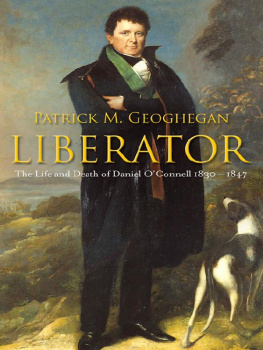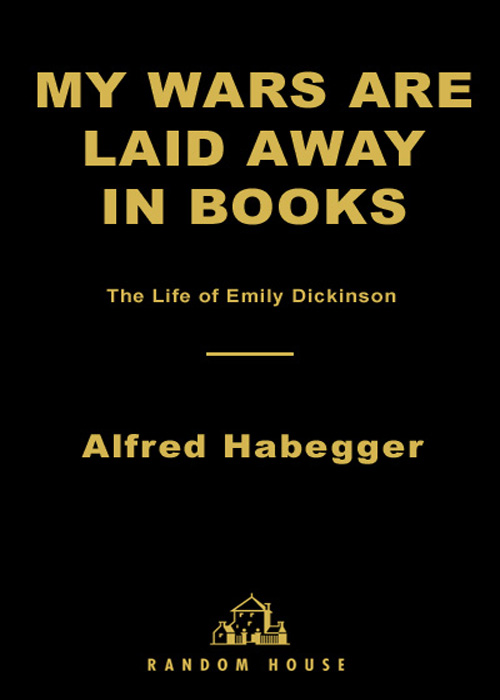
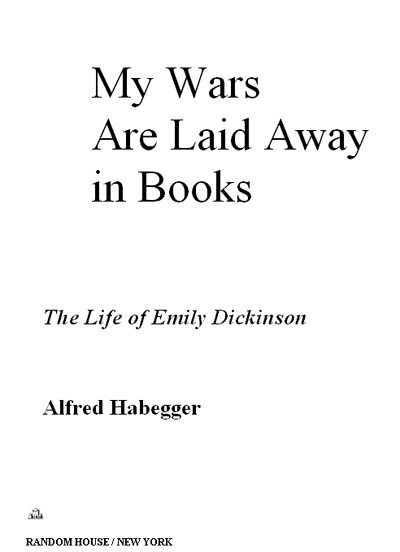
Contents
For Nellie
My Wars
Are Laid Away
in Books
Introduction
Any great writer who stands aloof from customs seen as fundamental is certain to be mythologized by posterity. For no one is this truer than Emily Dickinson, whose reclusiveness, originality of mind, and unwillingness to print her work left just the sort of informational gaps that legend thrives on. And yet there is no need to settle for the simplifying icons of her that pass for truth, including the icon of ineluctable mystery. In spite of the gaps, there are enough materials for a solidly documented narrative of her life covering the conditions that shaped her to the inner dynamics of her art and thought.
The present volume began with the feeling that it was time someone assess recent findings and claims relating to this poet, undertake a comprehensive review of the known sources on her, and conduct a determined search for new ones. Among the reflections that set me in motion (this was 1994) was the realization that it was two decades since the huge Dickinson midden had been sifted by Richard B. Sewall, still the best of the poets surprisingly few biographers. Since then, the feminist revolution had brought a number of rich new insights, conjectures, and perspectives to bear on her, some wonderfully illuminating. R. W. Franklin was about to complete his new edition of her poems, and certain theoretical approaches and isolated finds had opened fresh avenues into her life and work. But the more I read and taught her and considered competing claims, the more I felt that the story of her struggle and her genius was not being told.
Among the many ways readers have made sense of Dickinson, two approaches stand out. The older of them regards her as a pioneer, working in isolation and developing fifty years ahead of time the fractured thought and language that were to be characteristic of high modernism. The modernist Dickinson was not someone who could be patronized as eccentric, or explained as a product of New England Puritanism; it was her writing and not her person that merited attention. The other and more recent approach sees her as a woman of her time, an American Victorian intimately involved in female networks and responsive to female writers. This view builds on the groundbreaking 1975 article by Carroll Smith-Rosenberg, The Female World of Love and Ritual, and a great deal of specialized historical excavation, and rightly emphasizes that Dickinson had friends to whom she regularly sent letters and poems.
Each of these two approaches gets a great many things right. But aside from the obvious fact that they are fundamentally opposed and irreconcilable, both distort her historical reality. Their inadequacies will appear as this book unfolds. What must be noted here is the dubiousness of construing this profoundly one-of-a-kind writer by first enrolling her in any group at all, no matter whether it is the contemporary group of close female friends or the future group of detached modernists.
It seems wiser to begin and perhaps end with a recognition of the things that make Dickinson stand outher genius, her extremely tenacious affection, her avoidance of public life, her reluctance to publish. Whatever her final intentions for the nearly eighteen hundred poems she left behind, the fact that a great many were not communicated to friends warns us that we cannot assume, as we of course do with most writers, that she meant to be read and understood. What George Steiner has said of a poem by Paul Celan applies even more exactly to a large proportion of Dickinsons work: At certain levels, we are not meant to understand at all, and our interpretation, indeed our reading itself, is an intrusion.
The tacit recognition that our reading of Dickinson is an intrusion has all along contributed to her appeal. One of the reasons readers at all levels respond to her with passionate enthusiasm is that, knowing something of her life and character, they approach her work with these in mind. Again and again, readers feel that, remote and difficult as she is, they are on the track of knowing her. They feel a heartbeat; they receive the words as primal and immediate, as coming straight from life. Sadly, this way of reading is generally a mistake, especially if we succumb to the illusion that we can zoom into her life and penetrate her secret being. One of Dickinsons paradoxes is that she both invites and deflects such intimacy. Not telling was one of the things she did to perfection. How that came to be is part of the story this book attempts to follow.
Coming to this project after having written about the James family, I was struck by an assumption pervading a great deal of the critical analysis of Emily Dickinson. With almost anyone elseCharles Dickens or George Eliot or Henry James or James Joyce or T. S. Eliotit is taken for granted that the life has some sort of shape or curve, however complicated, and that if we know where on that curve a particular work is situated we will probably come to a better understanding of it. There is development over time, in other words, and this directional trend becomes a map by which readers steer. With Dickinson, however, it is often assumed there is no map, direction, or developmentthat her art was static or airless and that we dont need to know about her stages, sequences, contexts in order to catch on. Her critical expositors habitually move back and forth between her writings of the early 1860s and those of the 1870s and 1880s, as if to rule out in advance that a given work had much to do with the point she had reached when she wrote it, and that the points connected. It is as if this writer were freakishly unable to learn from experience, and wrote without traction all her life. This approach was made explicit some years ago by David Porter, an influential Dickinson critic, who based his analysis of her as modernist on such premises as these: that a chronology of composition has so far been impossible to establish and that her art did not change over more than two decades of composition.
It is true and indeed notorious that Dickinson wrote in the same few verse forms all her life, and that she always sounds like Dickinson, and that readers are easily lulled. But her stitched manuscript books, loose copies and drafts, and poems sent to others have been dated with varying degrees of exactness, and thus we can follow her tracks in a very rough chronological sequence. The feeling that she somehow failed to grow arises less from the oeuvre as such than from the problems we encounter in trying to read it. Aside from the inherent obscurity of some of her work, we meet two sets of practical problems: editorial and biographical. Since she did not date her verse or write for the press, choosing instead to trust a fraction of her output to close friends while keeping most of it to herself, we dont know how to organize it, frame it, or even set it up in type. The biographical problems are equally daunting: many of her letters are not dated; those to key correspondents have been destroyed or tampered with; and those she received are almost entirely gone, making it next to impossible to understand some of her replies and assess some relationships. And then there is the dearth of recorded incident that resulted from her reclusiveness. Any honest attempt to narrate her life, especially certain phases, ought to begin by acknowledging such difficulties.
But that there were
Next page

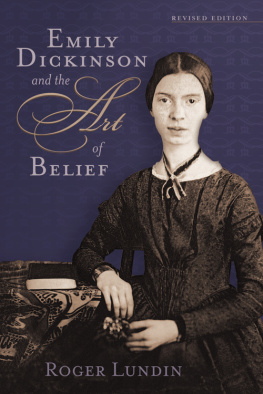
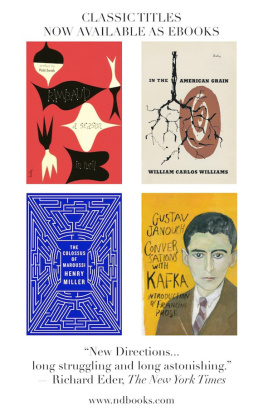
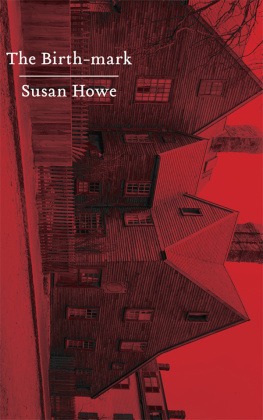
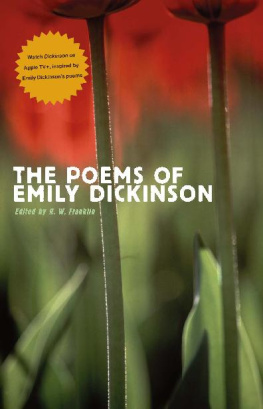
![Alcott - Louisa May Alcott: [a personal biography]](/uploads/posts/book/163779/thumbs/alcott-louisa-may-alcott-a-personal-biography.jpg)
